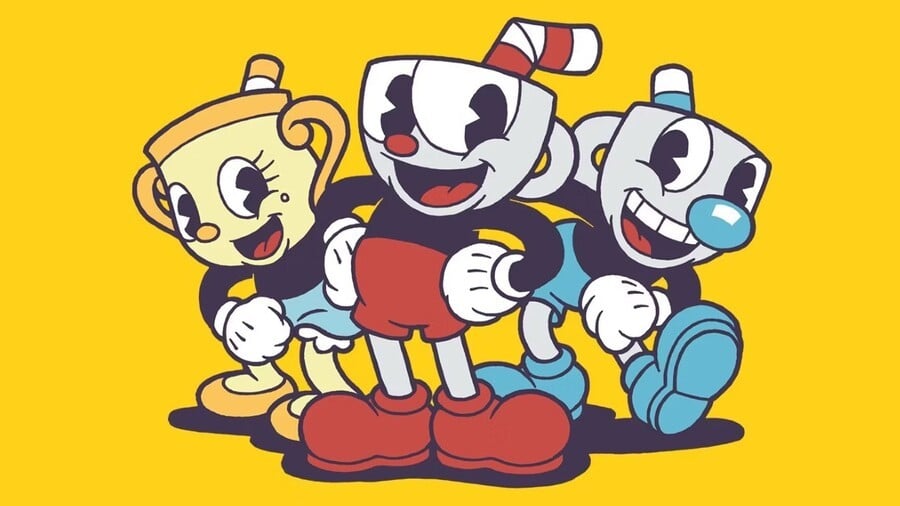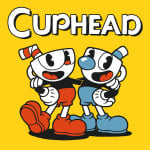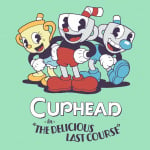Nintendo Life: By our count, you’ve been working on Cuphead in some form for around 12 years now! In what ways has the Studio MDHR team and your approach changed/evolved in that time?
Maja Moldenhauer : Wow! When you phrase it like that, it really underscores how long these characters and the world they inhabit have been a part of our lives. In the time since we began work on the project that would become Cuphead, one of the best ways our team has changed is that it has grown to include all the wonderful people we get to work with daily. We’re still a relatively nimble team of around 20 people, but even that is a far cry from the handful of folks working on Cuphead in its earliest stages.
In terms of our approach, we’ve undergone some of the same changes many studios go through as they make and release their first game. This includes better understanding the parts of our process that we can optimize, implementing ways to share knowledge more efficiently, and structuring our projects to maximize the wellness of our team. However, I think something that has served us well is one of the fundamental things that hasn’t changed but only gotten more prominent: our dedication to craftsmanship, and our commitment to ensuring that we invest lots of time and energy into even the smallest details of a project.
Partnering with the team at iam8bit was right for us because we had gotten to see first-hand the level of care and meticulousness they put into everything they do.
Given Cuphead’s massive success – how many indie games have their own TV show!? – we imagine you’ve been batting away boutique publisher offers to produce a physical version for years. How come you’ve waited so long to launch a physical version, and what made you decide to partner with iam8bit ?
Maja Moldenhauer : Perhaps the single biggest motivating factor to waiting for the release of the Physical Edition was our desire to ensure it represented the complete Cuphead experience. After the release of the original game, we knew internally that there were so many fantastical ideas and cartoon references we left on the cutting room floor, including the full story of how Ms. Chalice factored into our trio of main characters. Knowing that we were going to embark on the development of an expansion, we felt it only made sense to wait until we could guarantee players would get to experience the whole story!
Partnering with the team at iam8bit was right for us because we got to see first-hand the level of care and meticulousness they put into everything they do. We were fortunate enough to produce many smaller projects with them over the years, including several releases of our Cuphead soundtrack on vinyl , limited edition posters, and more. Seeing their dedication to getting every detail just right, and watching them go the extra mile on things like paper stock and materials gave us confidence that they would bring the game to life in a special way!
How much input did you have over the extras that come with the Collector’s Edition of the game?
Chad Moldenhauer : We were deeply involved in the full process! Like any project, the Collector’s Edition and Physical Edition of Cuphead was a collaborative effort. Together with iam8bit, we discussed what physical objects and collectibles felt at home in the era our games pay homage to while carefully considering what longtime fans might want to see.
Once we zeroed in on the idea of the Collector’s Edition orbiting around a hand-crafted marionette, we were extremely fortunate to find that the artisans at Rici Marionettes in Prague were keen as well! They’ve been working on puppets and marionettes for over three decades, and immediately understood our goal of creating something that feels as if it could have been assembled from the timeless, classic materials that would have been available to toy makers in the 1930s. From there, the idea of housing the marionette in a theatre stage box that pays homage to our Sally Stageplay level in the game evolved really naturally!
Together with iam8bit, we discussed what physical objects and collectibles felt at home in the era our games pay homage to while carefully considering what longtime fans might want to see
For many of the other collectibles included in both editions – from the 'Cuphead Funnies' comic cards to the Cuphead Club Membership to the Inkwell Isles Map to the Reversible Interior game box art – we illustrated them by hand in-house!
On the topic of the Netflix show, how involved are you with it day-to-day? After having so much control over the game, how did you find opening up and collaborating with a whole other team on the project?
Maja Moldenhauer: One of the wonderful things about finding a partner like Netflix and working with Netflix Animation was the way they innately understood the things that were most important to us about bringing our characters into a new medium: from maintaining the hand-drawn feel to emulating painted backgrounds to crafting stories that were both heartfelt and humorous. The entire team of animators and artists, led by showrunners Dave Wasson and Cosmo Segurson, poured themselves fully into crafting the best version of the Inkwell Isles possible.
We were certainly there to help guide them, provide insights into our characters, and give feedback on episodes and storylines – but we quickly realized from the outset that the world of Cuphead was in extremely capable hands. That allowed us to keep the majority of our focus on crafting our games, and we’ve gotten to enjoy the show as fans ourselves!
Returning to the game itself, do boss designs evolve much over the course of development, or do they tend to stick closely to your initial ideas? How long does it take to draw a single frame of a boss?
Jared Moldenhauer : I imagine almost every developer, independent or otherwise, would tell you that design is an extremely iterative process. For us, there are as many instances in Cuphead of bosses who started out with a clear idea for a '30s reference or visual motif as there are bosses who were initially anchored by certain mechanics and design ideas. It’s almost an impossible “chicken and egg” scenario because the two processes have to be symbiotic and responsive to one another, with art guiding mechanics and design steering art.
As for a single frame of a boss, that’s a great question and one that differs from stage to stage! In the case of The Delicious Last Course, for example, bosses like Glumstone the Giant had extremely high “pencil mileage”, as each frame of his fight required our team to depict a massive giant in motion, while other characters like the dancing bug in the second phase of the Moonshine Mob stage involved a much smaller character – albeit one whose motions were detailed and nuanced. Single frames can take anywhere between a few hours and a full working day!
there are as many instances in Cuphead of bosses who started out with a clear idea for a '30s reference or visual motif as there are bosses who were initially anchored by certain mechanics and design ideas.
While the visuals draw attention, the game’s soundtrack is equally spectacular. Is the music written for every boss specifically, or are tracks assigned once the bosses have already been created?
Jared Moldenhauer : The answer to this changed from the original Cuphead to The Delicious Last Course! So much of the original game was a learning experience as we dove headfirst into game development, and our amazing composer Kristofer Maddigan – who we’ve known since childhood – brought a spectacular background of classical and orchestral composition. Together, we were often flying by the seat of our pants, excited to give Kris high-level guidance and let him evoke certain themes and motifs from the era; from there, we’d often end up with a great tune and consider which boss paired best with it.
However, in the case of The Delicious Last Course, we deliberately took an evolved approach, trying to capture the sound of the Golden Age of Hollywood and the earliest major animated motion pictures, whose sweeping soundtracks really began to cement the idea of bespoke music composed to picture. Kris dug into the visual style of each boss and stage as it took shape and was able to put real thought into what motifs and musical themes suited them best. We couldn’t be happier and prouder with the result!
Having seen the marionettes in the physical edition reveal , it got us imagining an entire Cuphead game in a Supermarionation style. Do you think a Cuphead game could transfer to other forms of presentation, or is the vintage animation aesthetic a fundamental part of its DNA?
Chad Moldenhauer : We’re massive fans puppetry and stop motion, as our fans have come to see in many of the promotional trailers we do! For us, a love of physical materials, traditional processes, retro design sensibilities, and meticulous craftsmanship are some of the things that are central to the way we work at MDHR. I feel like those things will remain cornerstones of the projects we create!
we had no idea if the concept of a hand-animated cartoon platformer would resonate with anyone
Looking back over your many years developing Cuphead, what advice would you give yourself in a DM sent to 2010-you? Is there anything you would change about the game, or that you wish you had done differently?
Maja Moldenhauer : What a wonderful question! I think hindsight is 20/20, as they say, and something that might seem odd to say now but which we always felt at the time developing Cuphead was a sense of uncertainty. It’s not an exaggeration to say that we had no idea if the concept of a hand-animated cartoon platformer would resonate with anyone, let alone reach the amazing community it has. Reactions to our trailers at E3 and other showings certainly helped galvanize us and give us optimism, but that little bit of uncertainty always remained. On that note, I feel like I’d probably be sure to tell myself to stay the course, and remember that the most fulfilling work you can do is when you let go of those uncertainties and pour yourself into something you love!
With the game and characters having ballooned in popularity, does that put any pressure on the creative side to stick with the Cuphead ‘brand’? Are there non-Cuphead ideas you’re keen to explore in the future?
Chad Moldenhauer : At risk of giving the “boring” answer here, we don’t have anything specific to share about what we’re exploring or working on at the moment! We love the world of the Inkwell Isles and the characters that inhabit it, and also love that the industry we’re in is one filled with limitless possibilities for creativity. Where the long arc of the future will take us, I don’t even think we know just yet!
Finally, what games (on any platform!) have you been enjoying recently?
Jared Moldenhauer : I feel like it gets said every year, but it has been a fantastic year for video games of all scope and size. There are too many great releases to count, but some of the standouts from a quick survey of folks on our team include games like Elden Ring , God of War Ragnarok , Monster Hunter Rise: Sunbreak (which shares a release date with The Delicious Last Course!), Cult of the Lamb , Weird West , Rogue Legacy 2 , Shovel Knight Dig (I love Yacht Club’s well crafted retro experiences), and Poinpy . Of course, it wouldn’t be MDHR if we weren’t also preoccupied with some classic titles, and I owe a shoutout to the wonderfully seedy Mega Drive nostalgia boost classic, Huntdown !
This interview has been lightly edited for clarity. A huge thank you to Maja Moldenhauer, Chad Moldenhauer, and Jared Moldenhauer for taking the time to speak to us.
Cuphead's Physical Edition — which includes The Delicious Last Course — is available now on the iam8bit store .







